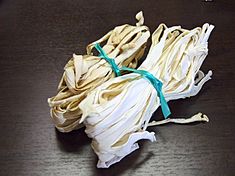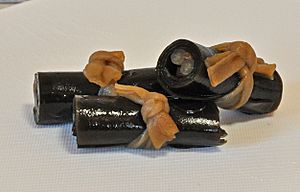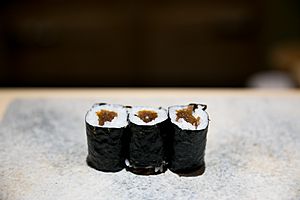Kanpyō (food) facts for kids

Kanpyō (raw), dried shavings of Lagenaria siceraria var. hispida
|
|
| Nutritional value per 100 g | |
|---|---|
| Energy | 1,079 kJ (258 kcal) |
|
65.03 g
|
|
| Dietary fiber | 9.8 g |
|
0.56 g
|
|
| Saturated | 0.045 g |
| Trans | 0 |
| Monounsaturated | 0.103 g |
| Polyunsaturated | 0.244 g |
|
Protein
|
8.58 g
|
| Vitamins | Quantity
%DV†
|
| Vitamin A | 0 IU |
| Thiamine (B1) |
0%
0 mg |
| Riboflavin (B2) |
4%
0.044 mg |
| Niacin (B3) |
18%
2.9 mg |
| Pantothenic acid (B5) |
51%
2.553 mg |
| Vitamin B6 |
41%
0.532 mg |
| Folate (B9) |
15%
61 μg |
| Vitamin B12 |
0%
0 μg |
| Vitamin C |
0%
0.2 mg |
| Vitamin D |
0%
0 IU |
| Minerals | Quantity
%DV†
|
| Calcium |
28%
280 mg |
| Copper |
22%
0.433 mg |
| Iron |
39%
5.12 mg |
| Magnesium |
35%
125 mg |
| Manganese |
54%
1.137 mg |
| Phosphorus |
27%
188 mg |
| Potassium |
53%
1582 mg |
| Selenium |
4%
2.6 μg |
| Sodium |
1%
15 mg |
| Zinc |
62%
5.86 mg |
| Other constituents | Quantity |
| Water | 19.97 g |
| Alcohol (ethanol) | 0 |
| Caffeine | 0 |
| Cholesterol | 0 |
| †Percentages estimated using US recommendations for adults. | |
Kanpyō (かんぴょう or 干瓢), also called kampyō, is a special food from Japan. It is made from dried strips of a type of calabash gourd. This gourd is known as yugao or fukube in Japanese.
Kanpyō is a common ingredient in traditional Japanese cuisine, especially in Edo style dishes. When cooked and flavored, it is often used in futomaki sushi rolls.
Contents
Where Kanpyō Comes From
Kanpyō was first grown in the Osaka area of Japan. Today, it is a special product of Tochigi Prefecture. Many families there make Kanpyō as a small home business. This area is so famous for Kanpyō that it even has a road called the "Kanpyō Highway with History and Romance."
The city of Oyama, Tochigi has a fun mascot named Kapyomaru (かぴょ丸). Kapyomaru is a friendly calabash gourd with a face and arms!
How Kanpyō is Made
Farmers harvest the gourds for Kanpyō between late July and September. The white inside part of the gourd is cut into long, thin strips. These strips are about 3 centimeters wide and 3 millimeters thick.
After cutting, the strips are either dried under the sun or put into special machines to remove the water. Each year, over 200 tons of dried Kanpyō are made!
Sometimes, Kanpyō sold in places like the United States might look very white. This is because it has been treated to make it brighter. Naturally dried Kanpyō usually has a creamy color. A substance called Sulfur dioxide might be used to help preserve it, but only in very small, safe amounts.
Dishes Featuring Kanpyō

Kanpyō strips are used in many delicious dishes. They are also often used as an edible "tie" to hold other foods together, like in fukusa-zushi and chakin-zushi.
To prepare Kanpyō for cooking, the dried strips are usually boiled until they are soft. Then, they are often boiled a second time with soy sauce, sugar, and other ingredients to give them a tasty flavor.
Here are some dishes that use Kanpyō:
- Futomaki: These are large sushi rolls that often include Kanpyō.
- Kanpyō-maki: These are sushi rolls with Kanpyō as the main filling. They are sometimes called teppo maki ("gun barrel maki") because they look like the end of a rifle.
- Matsukasa sushi: This is a special sushi roll that uses squid instead of nori (seaweed) to wrap around sushi rice, Kanpyō, shiitake mushrooms, snow peas, and whitefish.
- Shojin dashijiru: This is a vegan soup stock that can include Kanpyō.
Images for kids
-
Kanpyō drying in Minakuchi-juku from The Fifty-three Stations of the Tōkaidō by Hiroshige
See also
 In Spanish: Kanpyō para niños
In Spanish: Kanpyō para niños



